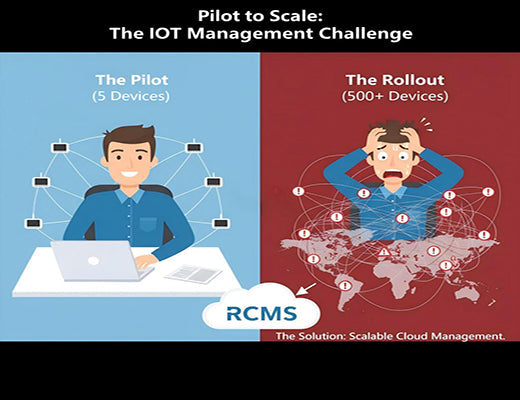
Why You Need a Cloud Platform for IoT Monitoring at Scale
|
|
Time to read 5 min
|
|
Time to read 5 min
While a single IoT monitoring device is easy to manage, a fleet of hundreds is a logistical nightmare without the right tools. This guide explains why you need a cloud platform for IoT monitoring at scale. We'll show how a dedicated IoT monitoring platform like Robustel's RCMS provides the essential tools for zero-touch provisioning, real-time fleet visibility, and remote troubleshooting, which are critical for building a scalable, reliable, and profitable operation.
Managing an IoT monitoring fleet without a cloud platform is not scalable and leads to massive, unsustainable operational costs (TCO).
A cloud platform for IoT monitoring solves the three biggest challenges of scale: mass Deployment, real-time Visibility, and remote Maintenance.
Key features to look for are zero-touch provisioning for automated setup, a centralized "single pane of glass" dashboard for visibility, and remote access for troubleshooting.
The platform's primary function is to dramatically reduce the need for expensive on-site technician visits ("truck rolls"), which is the key to a profitable IoT business model.
I've seen the story play out many times. An innovative company develops a brilliant IoT monitoring solution. Their five-device proof-of-concept works flawlessly. The sales team lands a massive contract to deploy 500 units across the country. The celebration in the office is euphoric, until the Director of Operations asks a terrifyingly simple question: "Who, exactly, is going to manage all of these?"
The celebration quickly turns to panic. The manual, hands-on process that worked for five devices has just become a logistical and financial black hole for 500.
Let's be clear: this is the "pilot to production" trap, and it has sunk more promising IoT projects than any technical failure. The solution is not to work harder; it's to work smarter. The solution is a cloud platform for IoT monitoring.

The "pilot and scale fallacy" is the mistaken belief that the processes used to manage a small pilot can be extended to a large-scale deployment. They can't. At scale, a manual approach fails catastrophically:
A cloud platform provides a "single pane of glass" to see your entire fleet.
This is where you attack your operational costs. A mature platform provides deep, secure access to your devices from anywhere in the world.

Why is all of this so important? Because it directly attacks the biggest hidden cost in any IoT deployment: the operational expense (OpEx) of maintenance.
Every time you can remotely solve a problem that would have otherwise required sending a technician, you are saving your company over $1,500 in "truck roll" costs. A powerful cloud platform for IoT monitoring can eliminate up to 90% of these site visits. The ROI is not just clear; it's massive. It transforms the financial model of your entire IoT business.

A cloud platform for IoT monitoring is not an optional accessory you tack on at the end of a project. For any deployment at scale, it is the essential, central nervous system of your entire operation. It is the tool that makes deployment feasible, management possible, and the entire business model profitable. Choosing a hardware vendor that provides a mature, secure, and deeply integrated cloud platform is the single most important decision you will make on your path to a successful large-scale IoT deployment.
Learn more in our main guide:
A1: A professional-grade platform is highly secure. You should look for vendors who can prove their security posture. This includes hosting on secure infrastructure like Microsoft Azure, following certified secure development processes (like IEC 62443-4-1), using strong end-to-end encryption, and conducting regular third-party penetration tests.
A2: They are complementary and serve two different, vital functions. The IoT application dashboard displays the sensor data (e.g., the temperature, the pressure). The device management platform (like RCMS) monitors the health and status of the connectivity hardware (the routers and gateways). You need both: one to see your business data, and one to make sure the devices sending that data are online and healthy.
A3: While some devices can connect to third-party platforms, it's highly advantageous to use a platform that is deeply integrated with the hardware (like RCMS with Robustel routers). This deep integration enables critical features like Zero-Touch Provisioning, detailed hardware diagnostics, and secure, reliable firmware updates that generic, third-party platforms often cannot match.